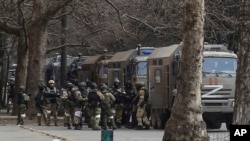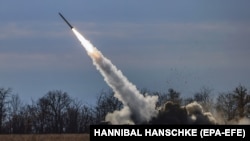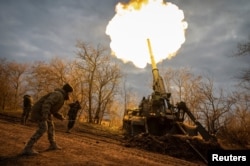Even before they pulled off their jaw-dropping counteroffensive in the northeastern Kharkiv region, Ukrainian troops had thrashed Russian forces in the Kherson region 600 kilometers to the southwest, aided by powerful and precise Western weaponry.
Live Briefing: Russia's Invasion Of Ukraine
RFE/RL's Ukraine Live Briefing gives you the latest developments on Russia's invasion, Western military aid, the plight of civilians, and territorial control maps. For all of RFE/RL's coverage of the war, click here.
Since mid-October, the Ukrainians had crept southward along the west bank of the Dnieper River, pushing toward a strategic and symbolic goal: the port city of Kherson. Some of Russia’s most elite units, including paratroopers from the 76th Guards Air Assault Division, made sure it was a grueling advance for them.
On November 9, however, Russian commanders said enough, and ordered the thousands of Russian troops on the Dnieper’s west bank -- up to 30,000, according to a top U.S. general -- to retreat to the east bank. If implemented in full, it would include abandoning the city of Kherson, the only regional capital Russia has seized since its invasion in February. That same day, Ukrainian forces hoisted the country’s flag over Snihurivka, a town that sits on a major road into the city, 60 kilometers south.
With that, Russia’s faltering eight-month-old invasion lurched into its newest phase, leaving analysts again wondering about the stamina of the Ukrainian forces, the incoherence of the Russian assault, and the political fallout for the Kremlin.
“It’s a huge political setback for Russia. This area was just annexed six or seven weeks ago -- you know, ‘Russia Forever’ and all that -- and now it’s being given up,” said Johan Norberg, a Russian military expert at the Swedish Defense Research Agency in Stockholm.
“It’s been militarily wise for a long time, but there has been a political reluctance in Russia to actually do this, because it is a setback. It is very hard to put lipstick on this pig…that what you annexed six, seven weeks ago is no longer yours,” he said. “But I think military necessity seems to have won the argument.”
The announced retreat is part of a pattern that Russian commanders have followed during the war, said Ben Barry, a former British Army brigadier and ex-director of the British Army Staff: For example, after failing to capture Kyiv, Russia pulled out of northern Ukraine and redeployed forces to the east for an offensive in the Donbas.
“What they have displayed is a degree of pragmatism, cutting their losses after operations have failed, this falls into this pattern we’ve seen before,” said Barry, now a senior fellow for land warfare at the International Institute for Strategic Studies in London.
“In military terms, they’ve made the assessment they can’t hold [the west bank of the Dnieper] without excessive risk and excessive casualties,” he said. “They see some benefit in shortening their front lines, crossing the river now under fire, which is a difficult thing to do in the best of times.”
'HIMAR The Hell Out Of The Bridges'
Russian forces hold most of the part of the Kherson region that is on the east bank of the Dnieper. That provides control of a ‘land bridge’ leading from Russia’s border with the Donbas to the isthmus that links mainland Ukraine to Crimea, the Black Sea peninsula Moscow occupied in 2014.
That Russia’s position on the Dnieper’s west bank was becoming indefensible had been clear for weeks.
The arrival of Western weapons --- U.S.-made HIMARS artillery systems and M777 howitzers, French-made Caesar howitzers, German-made Panzerhaubitze self-propelled artillery, among others -- gave Ukraine the ability to hit Russian targets further behind the front lines from a safer distance.
That includes river crossings like the Antonivskiy Bridge which was rendered impassable over the summer due to repeated HIMARS strikes. To resupply the west bank and rotate out units, Russian troops resorted to portable pontoon bridges and ferry crossings – which the Ukrainians also pummeled.
“I’ve said for weeks Russia could not sustain their presence on the right [west] bank, because the Ukrainians have HIMARed the hell out of the bridges,” said Konrad Muzyka, a Polish-based defense expert and owner of Rochan Consulting. The Dnieper’s west bank is also called the right bank, because it is on the right side as the river flows southward toward the Black Sea.
“[The] Russians will have to pull back sooner and now the Dnieper will become the front line,” he said. “But this is not going to be a walk in the park. Ukrainians will find it very difficult to cross the river especially as we’ve seen Russians building up fortifications on the [east] bank.”
“The Ukrainians will need a few weeks to rebuild their combat effectiveness, this is what happened after Kharkiv,” he said, “but whether they will be able to cross the river, set up a bridgehead, I don’t know how that’s possible right now.”
Hours after the announcement, General Mark Milley, the chairman of the U.S. Joint Chiefs of Staff, said that U.S. intelligence was seeing indications of a pullout of troops, whose number he put at 20,000-30,000.
“I believe they’re doing it in order to preserve their force, to reestablish defensive lines south of the river, but that remains to be seen,” Milley said. “Right now, the early indicators are they’re doing what they say they’re doing and we’re seeing those early indicators.”
Ukrainian Skepticism, Russian 'Maskirovka'
Then there’s the question of how the Russian announcement occurred.
General Sergei Surovikin, who was appointed early last month to take overall command of the war, made the recommendation during a televised meeting with Defense Minister Sergei Shoigu.
Shoigu, a Putin confidant and one of his longest-serving ministers, promptly agreed and issued the order in what appeared to be a choreographed display -- with Putin conspicuously absent. Shoigu has been under withering criticism from nationalists and military hawks for how the invasion has lurched and sputtered.
"I agree with your conclusions and proposals,” Shoigu said after Surovikin recommended the retreat. “For us, the life and health of Russian servicemen is always a priority. We must also take into account the threats to the civilian population."
"Proceed with the withdrawal of troops and take all measures to ensure the safe transfer of personnel, weapons and equipment across the Dnieper River,” he added.
The televised order -- a prime-time acknowledgement to the Russian public that things are not going according to plan -- drew skepticism from experts.
“What surprised me was the way this was announced, they just did it with such fanfare,” Norberg said. “Why make such a fuss about it on Russian TV?”
“I’m still surprised that Shoigu is still the defense minister honestly,” Muzyka told RFE/RL. “He really has to be super close to Putin to have survived because he is responsible for the Russian armed forces and their poor level of preparedness going into this war; he’s been the defense minister for 10 years.”
Also notable in the announcement was the fact that, just six weeks ago, Putin signed documents that the Kremlin baselessly asserted made Kherson and three other partially occupied Ukrainian regions parts of Russia. That means that the retreat order is a command to abandon territory that Moscow claims as its own.
Moreover, the fact that Kherson is the only regional capital Russian forces have captured since the February invasion means that losing it would be seen as yet another humiliating loss.
In May, during a trip to Kherson, Andrei Turchak, the top official in the Kremlin-controlled political party United Russia, pronounced the city forever part of Russia.
“I would like, once again, to say to residents of the Kherson region that Russia is here forever,” he said. “There should be no doubt about that.”
“Politically this is bad news for Russia because Putin is giving up a province that he had tried to detach from Ukraine,” said Mark Cancian, a military analyst at the Center for Strategic and International Studies in Washington.
“Militarily, it's very sensible,” Cancian said in an e-mail. “Russian forces on the west bank of the Dnieper were vulnerable. Pulling them back to the east bank will make them secure and free up some troops to strengthen the line elsewhere.
“There’s a lot of PR stuff going on around this withdrawal, which I don’t fully understand. I’m struggling to connect the dots,” Muzyka said. “The Russians are very public about this withdrawal to the point that it makes me suspicious about their intentions. There are many shades of gray in this war, and in this particular event.”
Challenges Ahead
Ukrainian officials shared that skepticism, suggesting that the announcement could be a feint to lure Ukrainian forces into a trap. Natalya Humenyuk, a spokeswoman for Ukraine’s Southern Command, told the Russian TV channel Dozhd that it could be a “psychological operations” measure aimed at masking Russia plans.
"Actions speak louder than words," Mykhaylo Podolyak, a senior adviser to President Volodymyr Zelenskiy, said in post to Twitter. “We see no signs that Russia is leaving Kherson without a fight…. Ukraine is liberating territories based on intelligence data, not staged TV statements.”
Still, any further Ukrainian advance -- either south to the city or southeast to the nearby riverbank -- will be problematic due to traps or slow, due to bridges and crossings destroyed by Russians to slow the advance.
Ukraine’s southern command said in a statement that troops were already confronting landmines and Russian-built roadblocks. Podolyak said Russian forces had mined “everything they can” in Kherson city, including apartments and sewers.
“The Russians will not give it away for free, militarily speaking,” Norberg said. “They've been there for a while, mines, putting booby traps in houses. They can also leave people behind so that when they go in, the Ukrainians will have to go into urban combat.”
In the spring, Russian troops laid siege to the port city of Mariupol, on the Sea of Azov, all but leveling it as Ukraine held them off in a tenacious defense. Kherson, by contrast, has been relatively unscathed, leaving the question: Does Moscow want to force Ukrainians into street-to-street fighting that could raze another sizable city.
“The question is more political than military. To what extent does Moscow want the Ukrainians to fight for the city and largely destroy it?” Muzyka said. “Russia could also leave behind some of their mobilized troops to fight for the city -- until they die.”
Among Russian military bloggers who have played a lively presence on Telegram critiquing the way the war has been conducted, the announcement of the retreat was viewed with dismay -- and another indication of deep institutional problems in the Russian military.
“What is happening is [the result of] a combination of catastrophic mistakes made, years and months of unsolvable problems and the lack of necessary funds,” the pro-Kremlin channel Voyenny Osvedomitel (Military Informer), said in a post just before the announcement. It said that “months of systematic erroneous decisions and failure to correct errors have snowballed and brought us here.”

















